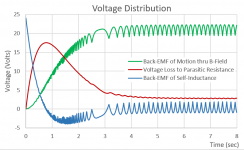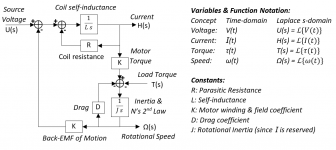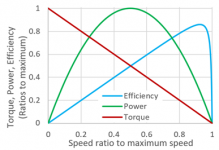Carultch
Senior Member
- Location
- Massachusetts
Here is the setup I've used for my simulation:Sorry... just trying to put this together... so in an AC 3-phase motor, the stator and rotor windings will initially have a back-EMF, due to the coils. But will be quickly overtaken by the back EMF generated by the coil's motion in the magnetic field, once the armature starts rotating?
DC motor
3 winding groups on the rotor
Electrical data:
Loop Area: 0.02 m^2
Magnetic Field: 0.1 Tesla
QTY of turns per winding group: 50 turns
QTY of winding groups: 3
Supply Voltage: 24 Vdc
Parasitic resistance: 250 milliohms
Self-inductance: 100 milli-Henries
Mechanical data:
Drag constant: 0.015 N-m/(rad/s), linear drag assumed
Rotational inertia: 0.2 kg-m^2
Load torque: 0.5 Newton-meters
Here are the graphs that I've simulated:
The voltage distribution shows how the 24V supply voltage distributes among the three elementary behaviors of the windings. In reality, these elementary behaviors are distributed throughout the windings, rather than lumped as idealized elements. The reason for the roughness is due to abs(trig) terms, that relate the mechanical back-EMF to speed, and the torque to current. If you had lots of winding groups, equally distributed around the rotor, the roughness would smooth out, and these plots would be sine waves enveloped by exponential decay, settling on the steady-state condition in the long run.
As you can see, the back EMF of the self-inductance initially dominates, and the back-EMF of motion overtakes it pretty quickly. There is a brief time when the self-inductance's back-EMF is negative, where it is assisting the voltage source and pushing its stored energy back in to the rest of the circuit, as the inrush current settles to its full load current. In the long run, the back-EMF of motion dominates the voltage that the motor consumes.
The current grows from zero first, and the rotation speed follows shortly thereafter. The current starts growing right away, since slow-moving motor behaves like an LR circuit. The rotation speed curve lags behind the current curve, because the current has to first grow from zero, to provide the starting torque to speed it up from rest.




